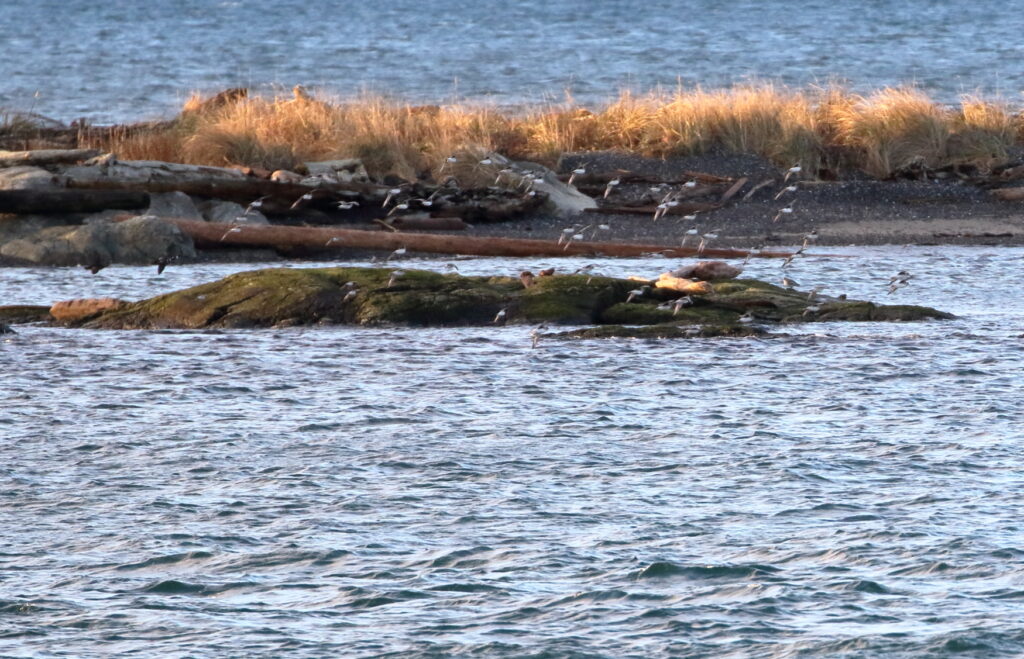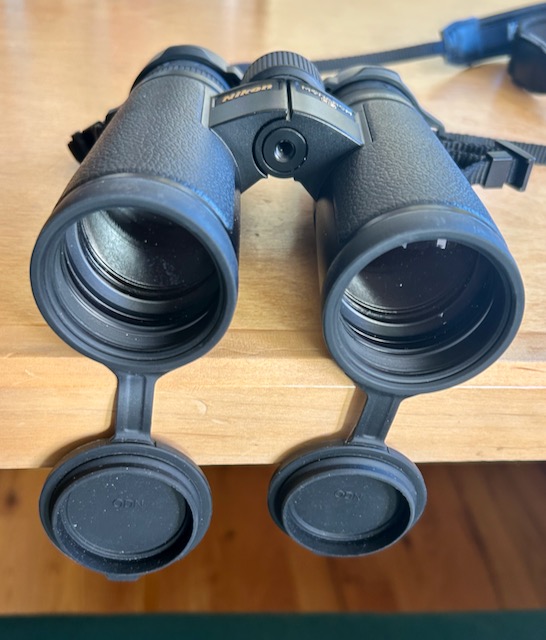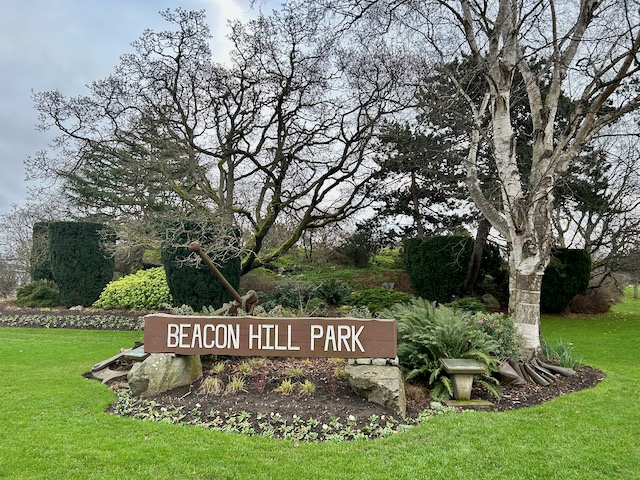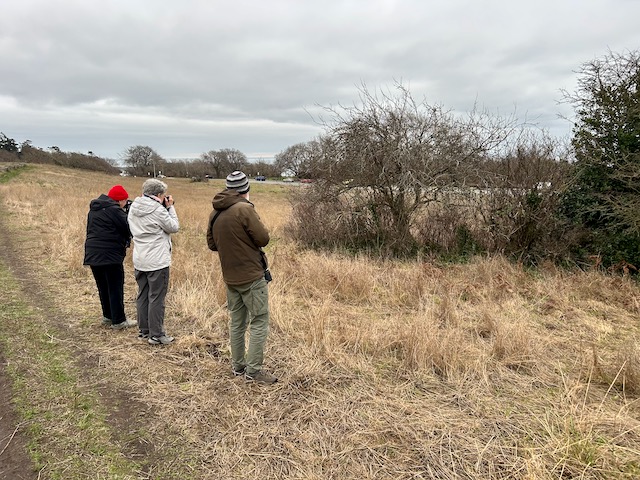After three nights in Victoria (see last week’s post “Birding Victoria, BC”), Amy and I headed up the Vancouver Island coast toward a spot where we had spent our first nights together as married folk—a lovely establishment called the Point No Point Resort. On the way up, I bamboozled Amy into stopping at one of the most well-known birding hotspots in the area: Whiffin Spit Park. As its rather humorous name implies, the park is a narrow spit of land stretching about a kilometer across the mouth of the bay where the town of Sooke is located, and it has recorded an impressive list of birds.

As Amy walked ahead, I schlepped my scope, zooming in on anything promising. Over the next hour, I found Red-breasted Mergansers, more Harlequin Ducks (Yay!), Surf Scoters, Common Loons, and most exciting, a pair of Pacific Loons. Along the path, I also got excellent looks at Black Oystercatchers and Black Turnstones. Alas, the numerous unleashed dogs did not create a bird-friendly environment, and chased off the birds several times. (Our dog, Lola, by the way, informed me that she would never engage in such unruly behavior—cough, cough.)

Despite these good birds, I had by now firmly set my mind on seeing alcids, a group of sea birds affectionately dubbed the penguins of the northern hemisphere. These birds include murres, guillemots, Razorbills, Dovekies, and puffins, but the ones I most wanted to see were murrelets. Two kinds frequented the area: Ancient and Marbled. My new birder friend John (see this recent post) had told me that Ancient Murrelets tended to fly around in groups while Marbled Murrelets were most often observed as loners floating on the surface. Either species would be a lifer for me, and I would have been ecstatic to find one. Alas, the task was proving much more difficult than I had hoped. I totally struck out in Victoria, and now I “whiffed” at Whiffin Spit, too.

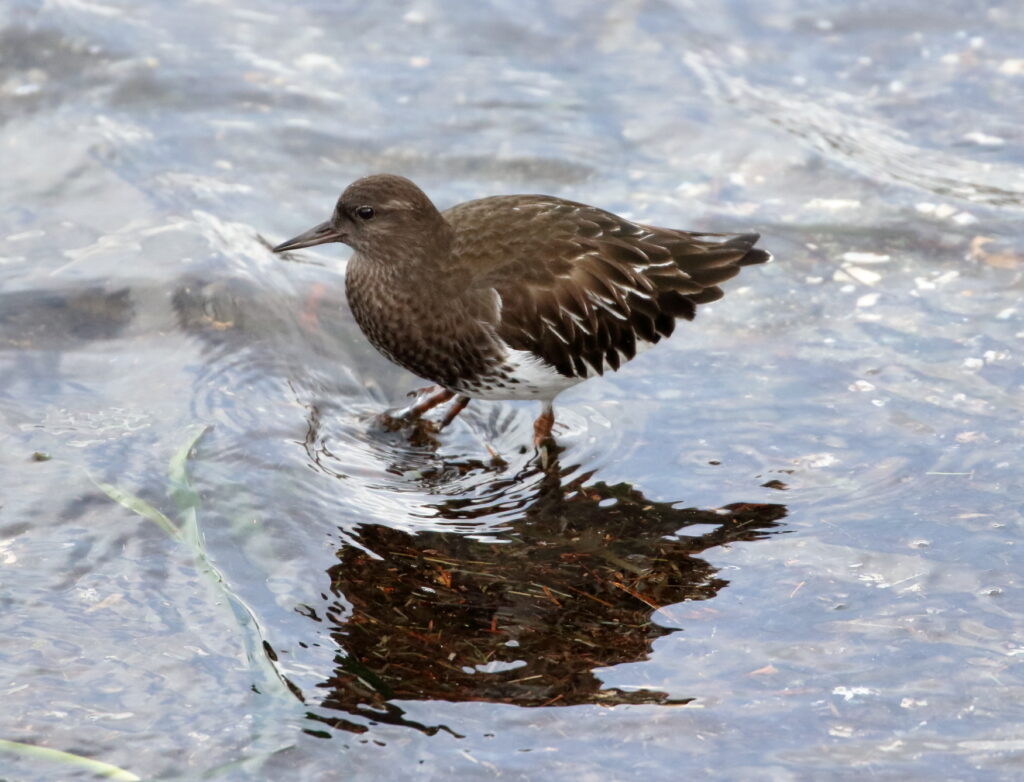
The Point No Point Resort helped ease my disappointment. The cabins and rooms are all cleverly designed for privacy and each looks out over the spectacular Strait of Juan de Fuca (part of the Salish Sea). The sun was setting by the time we checked in—just time for me to set up my spotting scope and find a raft of about forty Surf Scoters floating below us. They would become regular companions of our stay. I also noted a few cormorants and other birds, but alas, no alcids.

Undaunted, I rose the next morning to hit two nearby spots that had been recommended as great seabird locations: Otter Point and Muir Creek. The birding gods seemed stubbornly pitted against me. I saw a few more loons, including my first Red-throated Loon, along with my first Pacific Wren and a dozen or so species I’d been seeing for the past few days, but nothing that really got my heart racing.

This pattern repeated itself for the next couple of days as Amy and I explored several more places between Sooke and Port Renfrew. Honestly, the birds that most excited me were Short-billed Gulls (formerly Mew Gulls)—birds that I had never seen in such numbers, and had only recently become skilled at identifying myself.


Before we knew it, we arrived back at the Point No Point for our last luxurious evening of watching the sea and enjoying the view of the Olympic Peninsula across the water. As we prepared to soak in our private hot tub, though, I picked up my cool new binoculars (see our last post) for one final look at the ocean below us. In the rapidly fading light, I spotted our loyal raft of Surf Scoters, along with gulls and cormorants. Then, I noted a tiny speck in the breaking waves close to shore, and quickly focused in on it. I guessed it was a piece of kelp or driftwood, but then, through the lenses, the unlikely shape of a bird emerged!
My heart accelerating, I frantically set up the scope which lay at my feet and zoomed in on the shape. “No friggin’ way!” I exclaimed. Honestly, I didn’t know exactly what I was looking it, but I felt sure I hadn’t seen it before. I was also sure I needed some photos, no matter how crummy, so I switched out my scope for my camera on the tripod, and captured a few quick images through our windows before, to my disappointment, the bird drifted out of view behind some trees.
By this time, after a quick consult with my Sibley app, I felt positive that the tiny bird had indeed been a murrelet, but which kind? Studying my horrible photos and comparing them to Sibley, I noted the white patches on the shoulders and near the tail. That ruled out Ancient Murrelet. I also checked the illustrations for all the other alcids that might be in the area. Only one matched my photos: Marbled Murrelet! Even better, ten minutes later the bird reappeared below our window. By now, the light had grown truly dim, but I took my tripod and camera out onto the deck and managed some slightly better shots.

My fellow birders can imagine how that one bird pretty much made the entire trip for me. Everything else was just lovely, too, but a Marbled Murrelet? That put the icing on the cake, or for me, the chocolate chips in the cookie. It also sent my imagination racing, seeing that tiny bird deftly negotiate the waves crashing into shore. It was just so comfortable in an environment that would have snuffed me out in a matter of minutes.
Marbled Murrelets defy the imagination for another reason. Unlike other alcids, they nest not in burrows or on cliffs, but in trees! In fact, the nesting location of this bird remained a great ornithological mystery for more than a century as biologists looked everywhere (but not in the tops of trees, evidently) for a Marbled Murrelet nest. “Finally,” recounts Cornell Lab’s Birds of the World, “in 1961 and 1974, the first verified and published nests were reported in Asia and North America, respectively.”
Amazing.
Unfortunately, the birds prefer old-growth coastal forest, forests that have experienced extreme logging pressures over the past century. The birds have also been impacted by fishing gear, forest fires, and other hazards. As a result, the bird is listed as endangered or threatened throughout its North American range. That made it all the more remarkable that one had deigned to show up right below our picture window—almost as if following some kind of cosmic movie script. I felt very fortunate.

The next day, Amy and I returned to Victoria and another round of birding at Clover Point—my best session there yet. Pacific Loons, Buffleheads, Harlequin Ducks, and Surf Scoters seemed to be everywhere, and I was thrilled to find a pair of immaculately-feathered Long-tailed Ducks far out on the water. Though we would not head home until the following day, it was a great way to wrap up a trip that proved delightfully unexpected in so many ways. Huge gratitude goes to my wife and partner, Amy, for giving me such a wonderful surprise. And now, it was time for us to go celebrate with stiff umbrella drinks and a plate full of chicken enchiladas.






